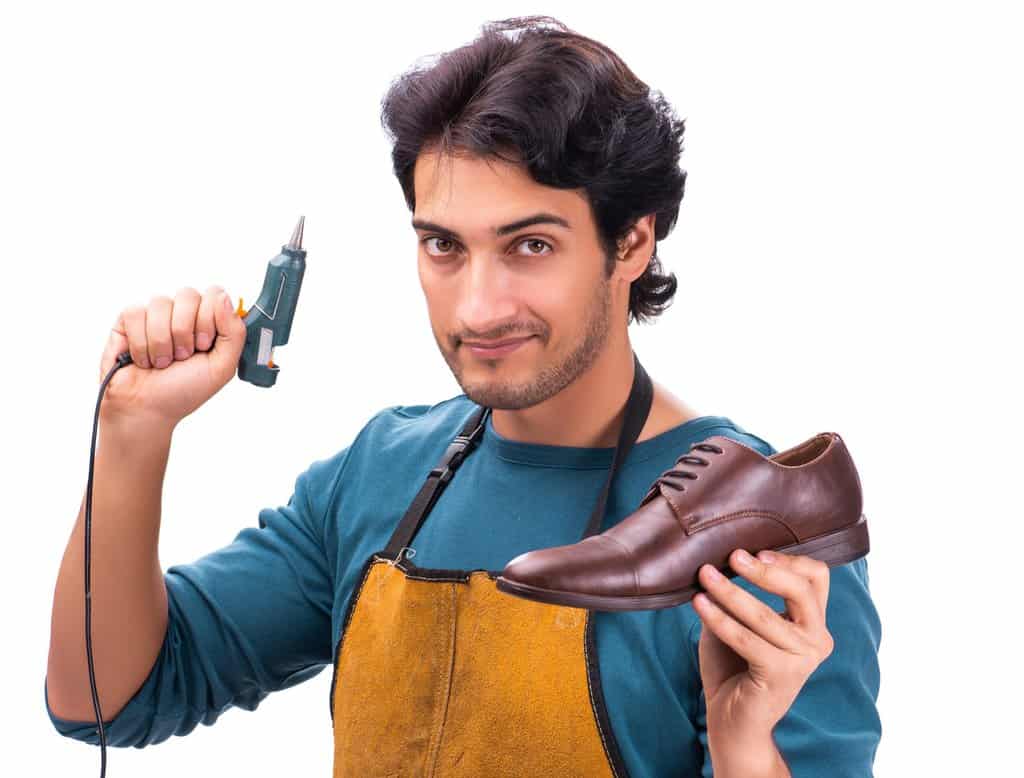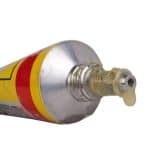Using a hot glue gun on many arts and crafts projects is okay as long as you’re being careful. However, it’s a different story when it comes to leather as you have to consider if it will work and if it won’t damage the leather material. In this article, we’ll be talking about using a hot glue gun on leather and how you can safely remove it in case there are any mistakes.
Does hot glue gun work on leather?
If you’re just looking for something to make the materials stick to leather, then yes, it will work using a hot glue gun. However, if you’re planning to spice up your leather garment or leather furniture with some designs and studs, we highly suggest you go for leather-friendly glues.
Does heat melt leather?
Real leather is made to withstand high heat and will most likely just get charred if heated up very high, but it won’t be engulfed in flames or melt. Heat will only damage the finishing or coating on the surface. On the other hand, for faux leather items, there is a huge chance that the protective layer will melt off with too much heat exposure. Synthetic leather will also almost burn or melt immediately under high heat since it’s made out of plastic elements.

Does hot glue stick to leather?
Hot glue is basically just melted plastic and once it dries up, it will not hold firmly compared to leather craft glue or bonding glue. So if we’re talking about real leather here, then most likely, no, hot glue is not enough to make it stick. However, for faux leather, hot glue can do the job of holding it together and sticking designs to it.
What materials can I use hot glue together with leather?
You can use a hot glue gun to attach studs, beads, and buttons on faux leather items. If you want to spice up your leather garment, there are many decorative items that you can glue onto the surface using hot glue. Otherwise, we don’t recommend using hot glue to repair leather items since there are more effective and better options for that.
Can you hot glue fabric to leather?
Yes, hot glue will hold if you try to stick fabric to leather surfaces. Although, you have to keep in mind that once it’s glued on, the materials are stuck long-term and it will affect their flexibility. Since hot glue guns are not water-based, you simply cannot remove them without damaging at least one of the items.
While the hot glue may not affect the structural integrity of the leather, it may leave some surface damage which can be unsightly if it is a fashion piece.
Using hot glue may also yield unpredictable results as the oils and conditioner on the surface of the leather may become a factor in the amount that it sticks.
Fabric glue will give you better results, but we suggest you clean the surface first to make sure it adheres well.
Can you hot glue leather to leather?
Hot glue is basically just melted plastic and once it dries up, it will not hold firmly compared to leather craft glue or bonding glue.
If you’re determined to stick two leather items together, you should invest in a good leather glue like Aleene’s Leather & Suede Glue. Not only will it do the job better, but you can also use leather glue for repairs and leather projects in the future. It also creates a flexible bond so your item isn’t stiff to use.
If hot glue is a last resort, you should clean the surface of any oils in case it interferes with adhesion. Hot glue is not the ideal type of glue to use, but you are still able to use it as a temporary solution.
Can I use hot glue gun on faux leather?
Yes, you can use a hot glue gun on faux leather items. In fact, it is safer if you only use it on faux leather instead of real leather, especially suede and nubuck. However, you have to remember that it is a pretty strong adhesive and there is a huge chance the material will be damaged if you try to remove it.
How to use hot glue gun on leather

You can use a hot glue gun for adding designs like studs on your leather item or for fixing an area with peeling (that you can’t sew). Even though there are definitely better options for doing these things, you can still opt for hot glue if you want to. Here’s how you can effectively and safely use a hot glue gun on leather:
For faux leather
Faux leather is the ideal material for using a hot glue gun on compared to real leather as it has more chance of holding since it’s plastic on plastic. However, this comes with the obvious risk that the hot glue might melt off the leather coating and expose the material to discoloration, dryness, and peeling. Do this at your own risk.
Here’s a simple method for using hot glue gun on faux leather:
- Clean the area you want to put hot glue on. Dust particles can prevent the hot glue from sticking properly onto the surface.
- Make sure that you don’t set the temperature too high on the glue gun. Set it at a low temperature of around 250°F to 380°F at a maximum.
- Avoid letting the heating tip get too close to the material.
For real and genuine leather
Using hot glue on real leather items is greatly frowned upon for two reasons. First, it doesn’t do what it’s supposed to do which is hold things together. Second, applying melted plastic material directly onto the leather surface can leave permanent marks and will just expose the leather to damage in the future.
Important notes:
- Real leather is a porous material and has more texture compared to smooth faux leather items. If you use hot glue on it, the hot glue will fill in the gaps (texture) of the material and ruin the quality.
- Those pores may aid you when using any sort of glue as it increases the surface area for adhesion.
Suede and nubuck
For obvious reasons, you should never use hot melted glue on suede and nubuck as it will greatly damage the material. Not only will you not be able to restore it to its former state, but you will also be dealing with a spot with an obvious stain on it forever.
How to remove hot glue from fake leather
If you accidentally smeared hot glue on faux leather, there’s no need to panic. Even though it is generally bad for the leather material, there are some ways you can remove hot glue from leather while making sure there is no or minimal damage to the leather item. Here’s how:
Using a scraper
The first thing you should do is avoid touching the hot glue. Get some ice cubes from the freezer and rub it onto the drying glue so it hardens faster. You can then proceed to scrape it off.
Find a scraper or an item with a dull edge so you can remove the dried hot glue. You should do this carefully as you don’t want to accidentally scrape off the leather coating if it has any or trigger the peeling of your faux leather item. After that, mix warm water with mild soap to form a lather. Wipe the area gently to remove any hot glue residue and finish off by wiping the surface with a soft dry cloth.
You may need to refinish the item in case the process ruins the finishing.
Using rubbing alcohol
If the scraping method doesn’t work on removing hot glue on the leather surface, you can use rubbing alcohol and cotton swabs instead. All you need to do is dip the cotton swaps in the rubbing alcohol and gently dab it on the edges of the dried hot glue. Allow it some time to react before slowly peeling the glue off the leather surface.
The best type of glue for leather
We understand that you may only have a hot glue gun at your disposal. However, there are better alternatives that you may have inside your home already; Contact cement! We would like to convince you to use that instead of a hot glue gun, if ever.
- Once you try this cement, you'll see why it's considered one of the best adhesives on the market
- Industrial use, all purpose cement provides a strong bond with just one coat
- Easy-to-spread, non-smearing, waterproof formula is flexible and long lasting
Contact cement is a great product that is able to adhere two surfaces very well. They are commonly used to repair shoe soles or bind pieces of wood that have a large surface area. Many leather glues actually use specially formulated contact cement, but they are still contact cement.
It would be better if you had leather cement, but all-purpose cement glues still work great. These are reliable glues and it’s hard to go wrong with them. Although, you will need to wear a mask as the fumes are intoxicating.
Contact cement quick use guide
To use contact cement, lay a thin but thorough layer of it on both surfaces of what you’re going to stick.
One of the most important parts of using contact cement is the waiting time. Leave the glue to dry out for 15-20 minutes. Do not stick them together prematurely.
After 15-20 minutes, the glue will feel tacky and not too sticky. However, when you put both pieces together, it will create an extremely strong bond. We then suggest you to add pressure to both sides and leave them for a few hours or overnight for the glue to cure.
The full cure time usually takes about 5-7 days for most contact cement brands and by that time they will reach their maximum strength.
Conclusion
There are many uses for hot glue and it’s a great tool if you want to add designs to your craft projects. However, if you want to add decorative items or fix a leather item, hot glue should only be your last choice if you’ve run out of options. There are more risks when using hot glue and it’s generally better to just stick with leather crafting products
FAQ
What kind of glue will stick to leather?
There are many types of leather adhesives available on the market today designed especially for leather crafting and you should go for those. You can also go for leathercraft cement like Barge All-Purpose TF Cement Adhesive for a stronger hold, but similar to Gorilla Clear Grip or Loctite 401, which are very strong adhesives, once you stick the items together, they will be permanent.
How long does leather glue take to set?
Leather glue takes about 1 to 3 hours for the bond to completely set. However, even though it’s dry, you should avoid using the item for another 24 hours just to make sure that full adhesion is achieved. It will also depend on how thick the application is and the temperature of the room you are working in.
What happens if you put super glue on leather?
If super glue lands on suede, it will forever damage the velvety texture of the material. For real leather items, spilling super glue on them can mean that the fibers will start hardening, making it dry, less flexible, and prone to cracking. For faux leather, super glue can ruin the surface texture and if you try to rip it off, it will damage the coating of the material.
Otherwise, if you put super glue on leather permanently and you’re satisfied with it, it works pretty well as an adhesive. If you’re interested and want to learn more about removing superglue from leather, you can check out our other article on how to remove superglue from suede, real, and faux leather.





